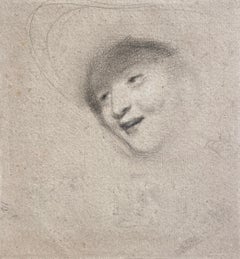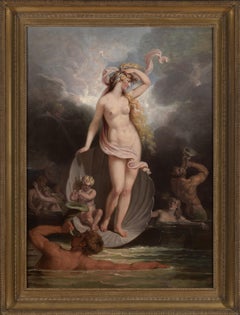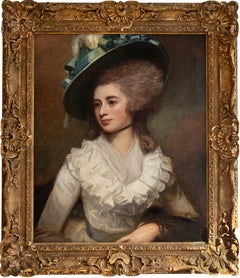Henry Perronet Briggs Art
to
1
1
2
2
1
Graphite Study of a Head, Monogrammed Victorian Sketch, Gilt Fame
By Henry Perronet Briggs
Located in London, GB
Graphite on paper, monogrammed lower left
Image size: 6 x 6 1/2 inches (15.25 x 16.5 cm)
Contemporary style handmade gilt frame
Henry Perronet Briggs
Henry Perronet Briggs RA wa...
Category
Early 19th Century Henry Perronet Briggs Art
Materials
Paper, Graphite
Juliet and her Nurse with the Page Peter from Shakespeare's Romeo and Juliet
By Henry Perronet Briggs
Located in Long Island City, NY
Artist: Henry Perronet Briggs, Attributed to, English (1793 - 1844)
Title: Juliet and Her Nurse with the Page Peter from Shakespeare's Romeo and Juliet
Year: circa 1820
Medium: Oil o...
Category
1820s Old Masters Henry Perronet Briggs Art
Materials
Canvas, Oil
Related Items
18th century allegorical painting of The Triumph of Beauty
Located in London, GB
Exhibited:
London, Royal Academy, 1800, no. 93
What was happening in British history painting in around 1800? In recent discussions of the emergence of a British School of history painting following the foundation of the Royal Academy in 1768, this is a question which is rarely posed and one which is not easily answered. Examination of surviving Royal Academy exhibition catalogues reveals a profusion of artists’ names and titles, few of which remain immediately recognizable, whilst endeavours to explain the impact of exhibition culture on painting - such as the 2001 Courtauld show Art on the Line - have tended to focus on the first and second generation of Royal Academician, rather than young or aspiring artists in the early nineteenth century. This makes the discovery and identification of the work under discussion of exceptional importance in making sense of currents in English painting around 1800. Executed by Edward Dayes...
Category
18th Century Old Masters Henry Perronet Briggs Art
Materials
Canvas, Oil
Portrait of Lady Caroline Price
By George Romney
Located in Miami, FL
DESCRIPTION: Perhaps the best Romney in private hands. If Vogue Magazine existed in the late 18th century, this image of Lady Caroline Price would be ...
Category
1970s Old Masters Henry Perronet Briggs Art
Materials
Canvas, Oil
Job Cursed by His Wife
By Giovanni Battista Langetti
Located in New York, NY
Provenance:
Alfred (1883-1961) and Hermine Stiassni (1889-1962), Brno, Czech Republic, by 1925; thence London, 1938-1940; thence Los Angeles, 1940-1962; thence by descent to:
Susanne Stiassni Martin and Leonard Martin, San Francisco, until 2005; thence by descent to:
Private Collection, California
Exhibited:
Künstlerhaus, Brünn (Brno), 1925, as by Ribera.
“Art of Collecting,” Flint Institute of Art, Flint, Michigan, 23 November 2018 – 6 January 2019.
Literature:
Alte Meister...
Category
1670s Old Masters Henry Perronet Briggs Art
Materials
Canvas, Oil
CAVALRY BATTLE - Antonio Savisio - Neapolitan School- Oil on canvas Painting
By Antonio Savisio
Located in Napoli, IT
Land Battle - Antonio Savisio Italia 2006 - Oil on canvas cm. 30x80
Gold leaf gilded wooden frame available on request
Maestro Antonio Savisio drew inspiratio...
Category
Early 2000s Old Masters Henry Perronet Briggs Art
Materials
Canvas, Oil
Untitled (Man Reclining on Tile Floor)
By Mark Beard
Located in New York, NY
Graphite and conté crayon on paper
Signed and dated, l.r.
This artwork is offered by ClampArt, located in New York City.
Mark Beard, born in 1956 in Salt Lake City, now lives in Ne...
Category
1970s Realist Henry Perronet Briggs Art
Materials
Paper, Graphite, Conté
World Series Bench - Chicago Cubs, Bryant, Rizzo & Russell, Graphite on Paper
By Margie Lawrence
Located in Chicago, IL
The "World Series Bench" by Margie Lawrence consists of three key players in the Chicago Cubs for the long awaited World Series win in 2016. From the ...
Category
2010s Contemporary Henry Perronet Briggs Art
Materials
Graphite, Paper
PORTRAIT OF A GENTLMEN - French School -Portrait Italian Oil on Canvas Painting
By Eugenio De Blasi
Located in Napoli, IT
Portrait of a Gentlemen - Oval oil on canvas cm.50x40, Italia, 2006 Eugenio De Blasi
Wooden frame available on request
The portrait of Eugenio De Blasi is inspired by one of the many portraits painted by Guillam Francois Colson, a French historian painter, who painted portraits of families...
Category
Early 2000s Old Masters Henry Perronet Briggs Art
Materials
Canvas, Oil
Shipping in Stormy Waters, Attributed to Italian Artist Francesco Guardi
By Francesco Guardi
Located in Stockholm, SE
The splendour of the tragic sea
Francesco Guardi and maritime painting in Venetian art
No Venetian painter was a stranger to the sea. After all, Venice was not only one of the most prominent ports of the Mediterranean, but indeed a city literally submerged in the ocean from time to time. Curiously however, the famous Venetian school of painting showed little interest in maritime motifs, favouring scenes from the iconic architecture of the city rather than seascapes. That is why this painting is a particularly interesting window into not only the painter Francesco Guardi himself – but to the significance of the element of water in art history, in absence as well as in the centre of attention.
Whether it be calm, sunny days with stunning views of the palaces alongside the canals of Venice or – more rarely – stormy shipwrecking tragedies at sea, water as a unifying element is integral to the works of painter Francesco Guardi (1712–1793). During his lifetime, Venetian art saw many of its greatest triumphs with names like Tiepolo or Canaletto gaining international recognition and firmly establishing Venice as one of the most vibrant artistic communities of Europe. While the city itself already in the 18th century was something of an early tourist spot where aristocrats and high society visited on their grand tour or travels, the artists too contributed to the fame and their work spread the image of Venice as the city of romance and leisure to an international audience, many of whom could never visit in person.
Still today, the iconic image of Venice with its whimsical array of palaces, churches and other historic buildings is much influenced by these artists, many of whom have stood the test of time like very well and remain some of the most beloved in all of art history. It was not primarily subtility, intellectual meanings or moral ideals that the Venetian art tried to capture; instead it was the sheer vibrancy of life and the fast-paced city with crumbling palaces and festive people that made this atmosphere so special. Of course, Venice could count painters in most genres among its residents, from portraiture to religious motifs, history painting and much else. Still, it is the Vedutas and views of the city that seems to have etched itself into our memory more than anything else, not least in the tradition of Canaletto who was perhaps the undisputed master of all Venetian painters.
Born into his profession, Francesco lived and breathed painting all his life. His father, the painter Domenico Guardi (1678–1716) died when Francesco was just a small child, yet both he and his brothers Niccolò and Gian Antonio continued in their fathers’ footsteps. The Guardi family belonged to the nobility and originated from the mountainous area of Trentino, not far from the Alps. The brothers worked together on more challenging commissions and supported each other in the manner typical of family workshops or networks of artists. Their sister Maria Cecilia married no other than the artist Giovanni Battista Tiepolo himself, linking the family to the most renowned Venetian name of the time. During almost a decade, Guardi worked in the studio of Michele Giovanni Marieschi, sometimes simply known as Michiel, a painted similar in both style and motif. Canaletto is, however, the artist Guardi is most often compared to since they shared a mutual fascination for depicting the architecture and cityscape of Venice.
During the course of his career, Guardi tried his hand in many different genres. He was as swift in painting landscapes, Vedutas of Venice, sacred motifs, interiors and architectural compositions as he was in a number of other motifs. His style is typical of the Venetian school but also distinct and personal once we look a little closer. There is an absolute certainty in the composition, the choice of which sometimes feels like that of a carefully calculated photograph – yet it is also very painterly, in the best sense of the word: fluid, bold, sensitive and full of character. The brushwork is rapid, intense, seemingly careless and extraordinarily minute at the same time; fresh and planned in a very enjoyable mixture. His interiors often capture the breath-taking spacious glamour of the palaces and all their exquisite decor. He usually constructed the motif through remarkably simple, almost spontaneous yet intuitively precise strokes and shapes. The result was a festive, high-spirited atmospheric quality, far away from the sterile and exact likeness that other painters fell victim to when trying to copy Canaletto.
The painting here has nothing of the city of Venice in it. On the contrary, we seem to be transported far away into the solitary ocean, with no architecture, nothing to hold on to – only the roaring sea and the dangerous cliffs upon which the ships are just moments away from being crushed upon. It is a maritime composition evoking both Flemish and Italian precursors, in the proud tradition of maritime painting that for centuries formed a crucial part of our visual culture.
This genre of painting is today curiously overlooked, compared to how esteemed and meaningful it was when our relationship to the sea was far more natural than it is today. When both people and goods travelled by water, and many nations and cities – Venice among them – depended entirely on sea fare, the existential connection to the ocean was much more natural and integrated into the imagination. The schools and traditions of maritime art are as manifold as there are countries connected to the sea, and all reflect the need to process the dangers and wonders of the ocean.
It could symbolize opportunity, the exciting prospects of a new countries and adventures, prospering trade, beautiful scenery as well as war and tragedy, loss of life, danger and doom. To say that water is ambivalent in nature is an understatement, and these many layers were something that artists explored in the most wondrous ways. Perhaps it takes a bit more time for the modern eye to identify the different nuances and qualities of historic maritime paintings, they may on first impression seem hard to differentiate from each other. But when allowing these motifs to unfold and tell stories of the sea in both fiction and reality – or somewhere in between – we are awarded with an understanding of how the oceans truly built our world.
In Guardi’s interpretation, we see an almost theatrically arranged shipwrecking scene. No less than five ships are depicted right in the moment of utter disaster. Caught in a violent storm, the waves have driven them to a shore of sharp cliffs and if not swallowed by the waves, crushing against the cliffs seems to be the only outcome. The large wooden ships are impressively decorated with elaborate sculpture, and in fact relics already during Guardi’s lifetime. They are in fact typical of Dutch and Flemish 17th century ships, giving us a clue to where he got the inspiration from. Guardi must have seen examples of Flemish maritime art, that made him curious about these particular motifs. One is reminded of Flemish painters like Willem van de Velde and Ludolf Backhuysen, and this very painting has indeed been mistakenly attributed to Matthieu van Plattenberg...
Category
18th Century Old Masters Henry Perronet Briggs Art
Materials
Canvas, Oil
Free Shipping
H 25.79 in W 29.14 in
Large 1700's Italian Oil Painting on Canvas Portrait of a Clerical Gentleman
Located in Cirencester, Gloucestershire
Portrait of a Clerical Gentleman
Italian artist, mid 18th century
Circle of Giovanni Battista Carboni (1725-1790)
oil on canvas, unframed
canvas: 26 x 22 inches
provenance: private c...
Category
Mid-18th Century Old Masters Henry Perronet Briggs Art
Materials
Oil, Canvas
"Veneer" Figurative Drawing, Color Pencil, Ballpoint Pen, Graphite
By Lauren Rinaldi
Located in Philadelphia, PA
"Veneer" is an original oil pastel, ballpoint pen, color pencil, and graphite on arches paper work by Lauren Rinaldi. This piece ships in the pictured archival custom frame. The pape...
Category
21st Century and Contemporary Contemporary Henry Perronet Briggs Art
Materials
Archival Paper, Oil Pastel, Ballpoint Pen, Color Pencil, Graphite
Late 17th century portrait of a French princess, daughter of Louis XIV
By Pierre Gobert
Located in PARIS, FR
Portrait of Françoise Marie de Bourbon, Duchess of Orléans as Venus
A magnificent painting depicting the princess in all the splendour of her youth, Françoise Marie de Bourbon, known...
Category
Late 17th Century Old Masters Henry Perronet Briggs Art
Materials
Canvas, Oil
Large 1700 Italian Old Master Nude Bather with Classical Figures Water Fountain
Located in Cirencester, Gloucestershire
Italian School, circa 1700's
Classical figures in landscape
oil on canvas, framed
framed: 36 x 32 inches
canvas: 30 x 25 inches
provenance: private collection, UK
condition: very goo...
Category
Early 18th Century Old Masters Henry Perronet Briggs Art
Materials
Oil, Canvas
Henry Perronet Briggs art for sale on 1stDibs.
Find a wide variety of authentic Henry Perronet Briggs art available for sale on 1stDibs. You can also browse by medium to find art by Henry Perronet Briggs in canvas, fabric, graphite and more. Much of the original work by this artist or collective was created during the 19th century and is mostly associated with the Old Masters style. Not every interior allows for large Henry Perronet Briggs art, so small editions measuring 2 inches across are available. Customers who are interested in this artist might also find the work of Michela De Vito, George Romney, and William Bromley. Henry Perronet Briggs art prices can differ depending upon medium, time period and other attributes. On 1stDibs, the price for these items starts at $1,934 and tops out at $5,000, while the average work can sell for $3,467.


